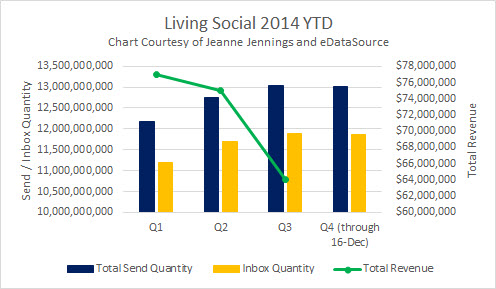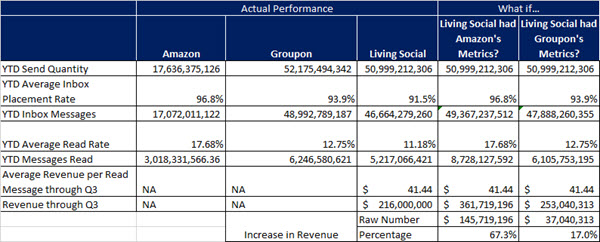Are the daily deal companies like Groupon and Living Social overly dependent on email? Living Social’s CEO said they were in a November press release which announced the company’s latest reorganization. But I find that difficult to accept — would there even be a daily deals industry without email? I think not.
This is one of three articles I’m publishing this week on Living Social and the daily deals industry. eDataSource was kind enough to let me use their Analyst NEXTGEN tool to gather data to investigate. Read the first article, which is my ClickZ Column this week and discusses inbox placement, read rate and send quantities. There’s a second item which has been published on the eDataSource Blog about send quantities, campaigns and performance.
And then there’s this one — which is all about revenue, one of my favorite things (so favorite that I’m missing the Sound of Music sing-along on TV to write this).
Living Social is a privately held company so, unlike Groupon which is public, they are not required to release financial results. But Amazon, one of their large investors, does report on Living Social revenue. So that’s where these numbers come from. The other data here comes from eDataSource’s Analyst NEXTGEN tool, a great competitive resource for email marketers.
I’m by no means an insider with regard to Living Social’s email program, these are just the musings of an interested outsider (Living Social is headquartered just over a mile from my home in Washington, DC so they are a local company and I have known people through the years who have worked there. But I didn’t speak with any of them for these articles).
Here are the figures I have for Living Social’s year-to-date 2014 revenue as reported by Amazon:
I’ve adjusted first quarter revenue to remove monies gained from the sale of Living Social’s Ticket Monster division to Groupon. So let’s chart these numbers in a few ways. First let’s look at send and inbox quantities as well as total revenue:
Ken Magill recently published an article about email frequency — he challenged readers to provide examples of email marketing programs that upped their frequency and had deliverability issues. The underlying hypothesis was that sending more email generated more money and didn’t cause deliverability issues.
But that’s not necessarily supported by the data I gathered about Living Social.
We don’t know how many people are on the Living Social list so we can’t speak directly to frequency. But the total send quantities have risen every quarter – and total revenue hasn’t increased. In fact it’s decreased — from a high of $77 million in Q1 to just over $64 million in Q3. We don’t have fourth quarter earnings yet, so maybe that will buck this trend. But maybe not.
And the inbox placement rate has decreased each quarter — it’s down from just over 92% to just over 91%. It’s a small change and it may be in the margin of error, but it is a decrease.
Revenue per 1,000 email messages delivered to the inbox (roughly RPME) has also decreased from nearly $7 to just over $5:
And we see the same thing when we look at revenue generated compared to the eDataSource read rate metric:
The actual number of email messages read in Q3 decreased compared to Q2, even though the send and inbox placement quantities increased. And the revenue per 1,000 messages read fell as well. From a high of over $60 in Q1 to a low of just under $50 in Q3.
In my ClickZ column I provide some ‘What If” scenarios for Living Social. What if they could match Groupon’s rate of inbox placement and reads? What if they could match Amazon (whom they share a lot of subscribers with, see my ClickZ article for more details) with regard to those same metrics. How would their audience engagement improve?
But the real question is how would their bottom line performance performance improve — because in the end that’s all that really matters. Here’s the ‘What If’ from my ClickZ column with revenue estimates added:
This is just an estimate, a guess. But it tells us that by improving the inbox placement and read rate metrics — but WITHOUT increasing the send quantity — Living Social should be able to boost revenue.
In fact, I did this with a client.
Their send quantities were increasing at a double digit pace (their business is cyclical so we looked at year-over-year quarterly figures) and their revenue per 1,000 emails sent (RPME) was decreasing at a similar pace. In 2013 and Q1 2014 we more tightly controlled the increase in send quantity, getting it down to at single digits if not a decrease from the previous year. And we worked on mailing smarter — more segmentation, testing creative to improve performance. We did everything EXCEPT dramatically increase send quantities. And revenue per email sent jumped dramatically. I stopped working with them after Q1 2014 so I don’t have more recent data, but they were very happy with what was happening.
Total revenue increased as well, but with new business units and products coming online during this period we can’t attribute all of that to the changes we made in the email program.
As with the other articles, this is not intended as a ‘silver bullet’ to solve Living Social’s financial issues. But it is food for thought for any business looking to improve the bottom line performance of its email marketing.












